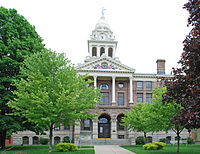Ionia County
| Ionia County, Michigan | ||
|---|---|---|

Ionia County Courthouse in Ionia
|
||
|
||
 Location in the U.S. state of Michigan |
||
 Michigan's location in the U.S. |
||
| Founded | March 2, 1831 (created) 1837 (organized) |
|
| Named for | Ionia | |
| Seat | Ionia | |
| Largest city | Ionia | |
| Area | ||
| • Total | 580 sq mi (1,502 km2) | |
| • Land | 571 sq mi (1,479 km2) | |
| • Water | 8.7 sq mi (23 km2), 1.5% | |
| Population | ||
| • (2010) | 63,905 | |
| • Density | 112/sq mi (43/km²) | |
| Congressional district | 3rd | |
| Time zone | Eastern: UTC-5/-4 | |
| Website | www |
|
Ionia County is a county located in the U.S. state of Michigan. As of the 2010 census, the population was 63,905. The county seat is Ionia. The Ionia County Courthouse was built by Claire Allen, a prominent southern Michigan architect.
Ionia County comprises the Ionia, MI Micropolitan Statistical Area, which is also included in the Grand Rapids-Wyoming-Muskegon, MI Combined Statistical Area.
The county is named for Ionia, a Grecian province. It was set off in 1831 and organized in 1837.
According to the U.S. Census Bureau, the county has a total area of 580 square miles (1,500 km2), of which 571 square miles (1,480 km2) is land and 8.7 square miles (23 km2) (1.5%) is water.
As of the census of 2000, there were 61,518 people, 20,606 households, and 15,145 families residing in the county. The population density was 107 people per square mile (41/km²). There were 22,006 housing units at an average density of 38 per square mile (15/km²). The racial makeup of the county was 91.96% White, 4.56% Black or African American, 0.56% Native American, 0.32% Asian, 0.01% Pacific Islander, 1.04% from other races, and 1.55% from two or more races. 2.78% of the population were Hispanic or Latino of any race. 29.0% were of German, 14.7% American, 11.6% English, 8.9% Irish and 5.3% Dutch ancestry according to Census 2000. 96.3% spoke English and 2.6% Spanish as their first language.
...
Wikipedia

